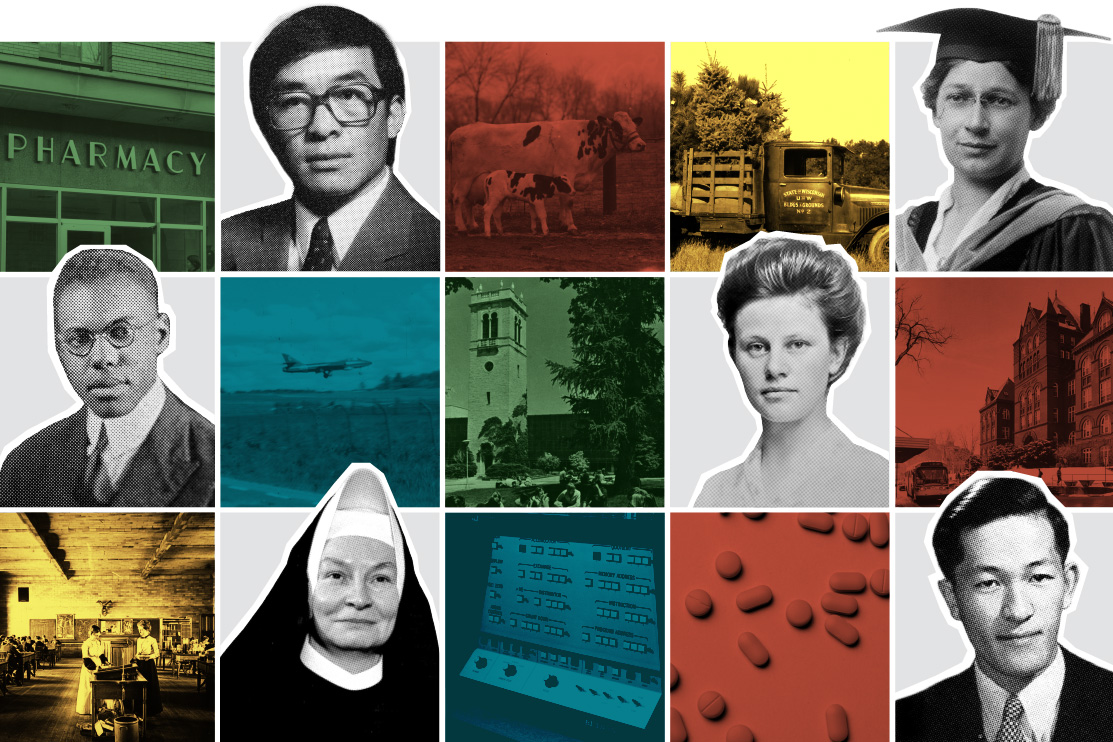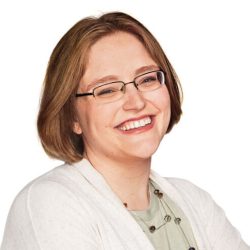Unsung Scientists
Despite significant contributions, these UW researchers have largely been forgotten by history.

From top to bottom are: Song Kue, Eloise Gerry, Leo Butts, Marguerite Davis, Sister Mary Kenneth Keller, and Miyoshi Ikawa. Their work had key impacts on modern marvels such as computers, blood-thinner medications, and vitamins. PHOTO ILLUSTRATION BY DANIELLE LAWRY. Marguerite Davis image courtesy National Archives, all other images courtesy UW Archives.
In subjects ranging from medicine to ecology, engineering to computer science, the University of Wisconsin’s top-ranked research program has made valuable innovations for the past 175 years. Just a few examples: Harry Steenbock 1916 revealed the benefits of vitamin D; Karl Paul Link 1922, MS1923, PhD1925 discovered the blood thinner warfarin, and James Thomson was a trailblazer in stem-cell research.
But what about some of the lesser-known UW scientists, often overlooked in their time, who made key discoveries? Science is a team effort, even if that isn’t always reflected in the history books. While the following scientists aren’t household names, the research they did and the training they received from UW–Madison helped advance their fields and improve the world.
Warfarin Warrior
Although most people haven’t heard of Miyoshi Ikawa MS’45, PhD’48, they probably have heard of warfarin, the medicine used as a blood thinner.
The story of warfarin, which was patented in 1947, began at the UW in 1933, when a farmer sought the help of biochemistry professor Karl Paul Link. The farmer’s cows, who were eating moldy sweet clover hay, began mysteriously dying from internal bleeding. The animals’ blood wasn’t clotting, so Link and his research team decided to find out why.
Once they discovered the chemical compound responsible for the cows’ thin blood, the researchers worked in the lab to create new variations of the substance, each with slight modifications to its chemical structure. Their goal was to maintain the compound’s blood-thinning effect.
Ikawa, a graduate student in the Link lab; fellow lab member Mark Stahmann PhD’41; and Link created analogue 42, the version that would become what we know today as warfarin. The researchers found the compound was useful as a rat poison. Later, they realized it could also be used as a drug to help people with blood-clotting disorders, a pivotal discovery that has saved countless lives.
Ikawa’s studies here, however, were linked to a darker part of our nation’s past. In the wake of the Japanese attack on Pearl Harbor in 1941, anti-Japanese sentiment was rampant in the United States. Ikawa was studying at the California Institute of Technology in 1942 when President Franklin D. Roosevelt declared the West Coast a military zone and authorized the forced evacuation and incarceration of more than 120,000 Japanese Americans. With the help of his CalTech graduate adviser, Ikawa was able to relocate to Madison and find a position in Link’s lab.
After finishing his graduate studies at the UW, he returned to the West Coast for postgraduate research at CalTech and UC–Berkeley and became a professor at the University of New Hampshire.
Computer Visionary
The first woman in the country to complete a doctorate in computer science was a UW–Madison grad — and a nun.
In 1932, at 18 years old, Mary Kenneth Keller PhD’65 entered the Sisters of Charity of the Blessed Virgin Mary. Soon after taking her religious vows, Keller began a teaching career and, during summer break, pursued a math degree. She was teaching high school math on the west side of Chicago in the early 1960s when she began to realize the rising importance of computers as a tool in mathematical computation. Intent on learning more, she attended a summer program at Dartmouth College, where she and other high school teachers learned how to operate computers and write simple programs.
Later, when Keller was in her 50s and teaching math during summer school at Iowa’s Clarke College, the school’s president sent her to UW–Madison to pursue a PhD in computer science. In her dissertation, “Inductive Inference on Computer Generated Patterns,” Keller explored the ways computers could be used to mechanize tasks and solve problems.
After earning her doctorate, Keller established the computer science department at Clarke College and gave lectures on computer science at other institutions whenever she could.
She was an avid proponent for women seeking higher education and for working women in general, especially mothers. She was even known to encourage her college students to bring their children to class.
Grade-A Scientist
We know that vitamins exist today thanks in part to the dedication of Marguerite Davis ’26.
Davis, a Wisconsin native, grew up inspired by the women’s rights movement in the late 19th century. She also had an interest in science and began pursuing higher education at the UW before transferring to the University of California to complete her bachelor’s degree. Called back to Wisconsin to help look after her father’s house, Davis hoped to continue her work in science.
Enter: Elmer McCollum, a professor in the UW Department of Agricultural Chemistry. In the early 1900s, McCollum was attempting to create a mixture of proteins, carbohydrates, and fats that could replace the standard feed given to animals and optimize their diets. But the animals fed on McCollum’s experimental diet experienced stunted growth, sickness, and even blindness. Something was missing.
With Davis’s help, McCollum began tedious and time-consuming studies to uncover what that something was, helping to feed, care for, and take detailed observations of lab rats.
Some rats were fed a dairy-based fat while others were fed olive oil or lard. The rats fed oil or lard became sick and failed to grow properly, but those who consumed dairy fat continued to grow. Realizing there must be important compounds in the dairy fat, McCollum and Davis extracted those compounds and added them to the oil and lard.
Their hypothesis was confirmed when rats fed the fortified oil or lard were as healthy as those fed dairy fat. In 1913, McCollum and Davis identified the important compound as vitamin A. The two guessed that other foods must also hold these vital nutrients, launching subsequent experiments to pinpint these substances and their benefits.
Each year Davis worked in the lab, McCollum requested a salary for her, but it wasn’t until her sixth year that he finally received the funding. Davis continued to make vital contributions, changing the field of nutrition as we know it.
Trailblazing Pharmacist
Leo Butts 1920 was the first African American to graduate from the UW School of Pharmacy. Butts grew up in Madison, where he was active in civil rights in high school. He became the first African American to play for the UW varsity football team and enlisted in the Students’ Army Training Corps.
But arguably his most important accomplishment at the university was his groundbreaking senior thesis researching the status of African American pharmacists. Butts pieced it together despite limited documentation in the UW libraries. He reached out to prominent African American pharmacists and pharmaceutical organizations, collecting anecdotes and statistics on the number of existing African American pharmacists and drugstores.
In his thesis, he also demonstrated the benefits of increased cooperation between African American doctors and pharmacists: improvements in the health of Black communities and their sense of connection.
After graduating, Butts worked as a pharmacist in Gary, Indiana, but he lost his job during the Great Depression and worked for a time as a mail carrier. Eventually, he returned to his chosen profession, operating a pharmacy until he passed away in 1956. He provided both care and a gathering place for his community.
Unfortunately, the sparse information on African American pharmacists persisted into the 1980s, when James Buchanan ’43, the School of Pharmacy’s second known African American graduate, found himself wondering if he had been the first.
She Saved Trees before It Was Cool
The nation’s first woman microscopist was a UW graduate and professor. Eloise Gerry PhD1921 moved to Madison in 1910 to join the U.S. Department of Agriculture’s then-new Forest Products Laboratory. The lab conducted innovative wood and fiber-use research that contributed to the sustainability of forests. Gerry also continued her education, studying botany and plant pathology. Later, she became a professor at the UW.
In 1916, she started her own research program to help conserve pine trees in the American South. Traveling around the region to collect data, she showed that the lumber industry was cutting down trees at an unsustainable rate. Her research helped to preserve local ecosystems and stabilize the pine-related turpentine industry by enabling more productive and longer-lived trees.
Gerry was proud to be a woman in her field. When she was hired at the Forest Products Laboratory, she recalled that “there wasn’t any man willing to come and do the work.” After earning her doctorate, she was sure to sign her full name, “Dr. Eloise Gerry,” rather than just her first initial and last name so that people would know she was a woman.
She made a point of being active in numerous professional associations, most notably serving as the president of Graduate Women in Science, a global organization that still works to inspire and support women in science. The organization established a fellowship in Gerry’s name that continues to offer research funding to selected fellows.
Education Advocate
Song Kue ’82 was UW–Madison’s first Hmong graduate. His electrical engineering degree made him a highly sought-after employee, and he was recruited by the electronics company E-Systems, where he designed technologies that improved the ability of fighter jets to detect military movement.
Kue and his wife, See, came to Sheboygan, Wisconsin, as Vietnam War refugees in 1975. He spoke some English and was encouraged to pursue higher education at UW–Green Bay’s Sheboygan campus. Kue had experienced limited access to communications while living in Laos, so he decided to apply his interest in computers and mathematics to electrical engineering with hopes of improving communication technology.
He soon transferred to UW–Madison to finish his bachelor’s degree. The Hmong community in Madison was small at that time, and his college career at a primarily white institution didn’t come without challenges. But as an avid soccer player, he was a strong supporter of the university’s soccer team and was proud to be a Badger.
Math was an equalizer to Kue. He saw higher education as a path to success and instilled that belief in his children and among the growing Hmong community in Madison, whom he often tutored in math. He encouraged them to pursue higher education, and several of his children, numerous nieces and nephews, and some of his grandchildren have since attended college, almost all of them at UW–Madison. •
Published in the Summer 2024 issue



Comments
No comments posted yet.